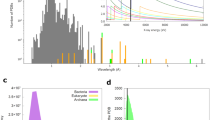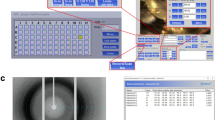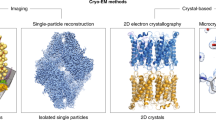Abstract
Synchrotron sources and the instrumentation of crystallography have improved together to ease macromolecular structure determination by diffraction methods.
This is a preview of subscription content, access via your institution
Access options
Subscribe to this journal
Receive 12 print issues and online access
$189.00 per year
only $15.75 per issue
Buy this article
- Purchase on Springer Link
- Instant access to full article PDF
Prices may be subject to local taxes which are calculated during checkout


Similar content being viewed by others
References
Wilson, I. et al. Structural biology and synchrotron radiation: evaluation of resources and needs.(19 June, 1998) http://www.ornl.gov/hgmis/biosync
Rosenbaum, G. & Westbrook, E.M. In Synchrotron radiation instrumentation: tenth US national conference, aip conference proceedings 417, (ed. Fontes, E.) 5 (American Inst. of Physics, Woodbury, New York;1997).
Stefan, P.M. et al. Small-gap undulator research at the NSLS: concepts and results. Nucl. Instr. and Meth. in the press (1998).
Nuhn, H.-D. Linac coherent light source. http://www-ssrl.slac.stanford.edu/lcls/lcls.html(19 June, 1998).
Westbrook, E.M. & Naday, I. Charge-coupled device-based area detectors. Meth. Enz. 276, 244– 268 (1997).
Tate, M.W., Eikenberry, E.F. & Gruner S.M. X-ray detectors for macromolecular crystallography. Synchrotron Rad. News 9, 19– 23 (1996).
Stanton, M., Phillips, W.C. & O'Mara, D. CCD-based detector for X-ray crystallography. Proc. Soc. Photo-Opt. Instr. Eng. 2278, 16– 20 (1994).
Barna, S.L. et al. Characterization of a prototype pixel array detector (PAD) for use in microsecond framing time-resolved X-ray diffraction studies. IEEE Trans. Nuc. Sci. 4, 950–956 (1997).
Ross, S. et al. Amorphous silicon, semiconductor X-ray converter detectors for protein crystallography. Nucl. Instr. and Meth. A 399, 38–50 (1997).
Skinner, J.M. & Sweet, R.M. Integrated beamline control software. Acta Crystallogr. D in the press (1998).
Otwinowski, Z. & Minor, W. Processing of X-ray diffraction data collected in oscillation mode. Meth. Enz. 276, 307–326 (1997).
Terwilligher, T. Automated crystallographic structure solution for MIR and MAD. (19 June, 1998) http://www.solve.lanl.gov
Crystallographic Binary Format Web Page (19 June, 1998) http://ndbserver.rutgers.edu/mmcif/cbf
Rodgers, D.W. Practical Cryocrystallography. Meth. Enz. 276, 183–203 (1997).
Garman, E.F. & Schneider, T.R. Macromolecular cryocyrstallography. J. Appl. Crystallogr. 30 211– 237 (1997).
Acknowledgements
This work, and beamline X12-C at Brookhaven's National Synchrotron Light Source, are supported by the United States Department of Energy Offices of Health and Environmental Research and of Basic Energy Sciences, and by the National Science Foundation.
Author information
Authors and Affiliations
Rights and permissions
About this article
Cite this article
Sweet, R. The technology that enables synchrotron structural biology. Nat Struct Mol Biol 5 (Suppl 8), 654–656 (1998). https://doi.org/10.1038/1344
Issue Date:
DOI: https://doi.org/10.1038/1344



